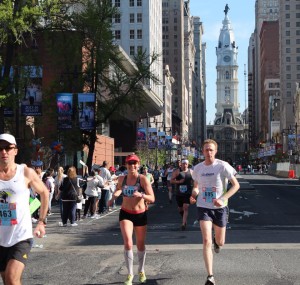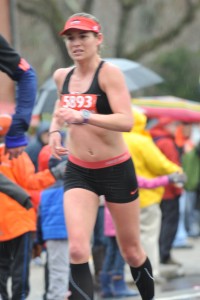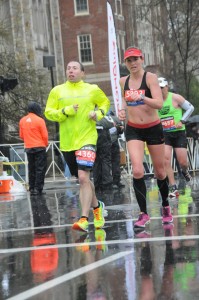Today’s blog is about nutrition habits. Many folks looking to hire a trainer or sign up for a marathon are hopeful that with committing to something physical, they will magically be able to eat everything they want and lose weight. It’s a nice thought, but usually not true. In fact, it’s not uncommon for folks to gain weight during their first season of training – because it is really easy to say “hey, I ran today!” and eat everything. It doesn’t take a brain surgeon to realize that burning 500 calories on a run doesn’t erase the calories in a burger and fries.
Did you know that many elite athletes are very careful about their caloric intake and nutrition habits? It may sound silly and unnecessary, but it’s quite often true. Folks who may be running 120+ miles per week are careful to not gain any weight. Yes, someone running 120 miles per week can afford to eat a hell of a lot more calories than the folks running 20 mile weeks, but my point is that to be their best, they need to be strong and as light as safely possible. The same is true with you and your goals, if they are based on pace and a time. If your goal is to lose weight, nutrition when training becomes incredibly important.
When I meet with new clients, I am sometimes told they want my physique. They joke to “sign them up” for whatever I am personally doing. I should also say that many friends and family assume I eat anything and everything all the time. I don’t. When I am visiting friends and family, I am often choosing to indulge. We are at a party, a celebration, out at a restaurant, a family get-together, or they simply see me on a day I am indulging because I simply want to. These same family and friends don’t believe me when I say that what they see me consume isn’t the norm. Do I eat bagels, cake or pizza everyday? Nope. Not even close. Do I talk about food, blog about it, dream about it and love it? Yes, guilty as charged. So I wanted this blog to showcase the reality of what it takes for me to be fit, strong, and extremely goal-driven – and perhaps you can apply some of what I do to your own life and goals.
Here are a few facts about me you may not know:
- I very rarely weigh myself. In fact, in the last year I have only weighed myself to keep track of dehydration levels when training and racing Ultra Marathons (12-24 hour races).
- I keep track of everything I eat, every day. I use an app. on my phone. I want to know what I am consuming and I find I need to keep myself accountable – be it calories, grams of protein, servings of fruits that day – I track EVERYTHING.
- I also track my activity. Hours of sleep, time standing, running, weight training. I keep all the data.
To show you what my nutrition usually looks like, I am listing below 2 random days from the past few weeks. One day is an “average” day for me, the other is a “rest day,” – and I tend to eat more calories and junk on rest days. I’ll also make note of my training on the “average” day.
Thursday, May 14th, 2015: an example of an “average” day for Coach Corky.
- Breakfast: Coffee, 2 TBS. Half/Half, 1 cup old-fashioned oatmeal, 1 cup fresh blueberries, 4 tsp. brown sugar
- Lunch: 1 large sweet potato, 5 tbs. parmesan cheese, 2 links of turkey sausage
- Dinner: 1 cup Goya black beans, 2 whole wheat tortillas, 1/2 cup shredded Mexican cheese
- Snacks: 1 orange, 1 Gala apple, 1/2 fresh pineapple
- Total calories consumed: 2084
- Training: weight trained for 1 hour, ran at a moderate pace for 1 hour
- Total calories burned: 2837
Saturday, May 9, 2015: an example of an indulgence day
- Breakfast: Coffee, 2 TBS. Half/Half, 1 large avocado, 2 eggs, 1/4 cup shredded cheese
- Lunch: 1 Larabar protein bar, 1 pint of Ben and Jerry’s Phish Food FroYo
- Dinner: Whole wheat pasta
- Snacks: 1 brownie, 1 orange, 1 Gala apple, 1 banana, 3 bottles of Sierra Nevada beer
- Total calories consumed: 3902
- Training: ran for easy coaching miles for 50 minutes
- Total calories burned: 2513
As you can see, some days I burn more than I eat and other days it’s the opposite. I usually try to focus on consuming fuel that makes me feel good – I want to be strong and healthy for my training. But I am also human, and am a really great stress eater.
A month or two ago, I decided I want to drop a little bit of body fat. Why? Well because if I want to be my fastest and my best out there for goal races, I need to be light. Trying to drop what little excess weight I have is tough. It’s like that last little bit your body is hanging on to and doesn’t want to give up. So I made sure to focus on weight training, running, and eating less than I burned. Did I lose the fat? Probably a little bit. But I am not going to lose sleep over it. I feel stronger, and am lifting more than ever before in my life, and am getting back to some speedy running and so things are going in the right direction.
Your journey and your goals are your own. Just be aware that when you see a coach, athlete or person on the street you don’t know – you have no idea what goes into their training and what genetics, sacrifices and dedication may have been necessary for what you see to be possible. Am I going to torture myself to be the lightest I can be? Nope. It’s not worth it to me. And as long as I feel healthy and capable of achieving what I want, the rest is gravy. Mmmm…gravy. No, I don’t eat gravy frequently. But it is damn delicious.









